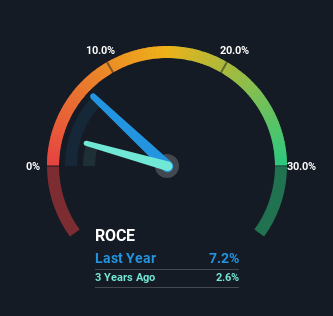- India
- /
- Energy Services
- /
- NSEI:JINDRILL
Returns On Capital Are Showing Encouraging Signs At Jindal Drilling & Industries (NSE:JINDRILL)
Did you know there are some financial metrics that can provide clues of a potential multi-bagger? In a perfect world, we'd like to see a company investing more capital into its business and ideally the returns earned from that capital are also increasing. If you see this, it typically means it's a company with a great business model and plenty of profitable reinvestment opportunities. So when we looked at Jindal Drilling & Industries (NSE:JINDRILL) and its trend of ROCE, we really liked what we saw.
What Is Return On Capital Employed (ROCE)?
For those who don't know, ROCE is a measure of a company's yearly pre-tax profit (its return), relative to the capital employed in the business. Analysts use this formula to calculate it for Jindal Drilling & Industries:
Return on Capital Employed = Earnings Before Interest and Tax (EBIT) ÷ (Total Assets - Current Liabilities)
0.072 = ₹1.2b ÷ (₹20b - ₹4.0b) (Based on the trailing twelve months to September 2023).
So, Jindal Drilling & Industries has an ROCE of 7.2%. In absolute terms, that's a low return, but it's much better than the Energy Services industry average of 2.9%.
Check out our latest analysis for Jindal Drilling & Industries

While the past is not representative of the future, it can be helpful to know how a company has performed historically, which is why we have this chart above. If you want to delve into the historical earnings, revenue and cash flow of Jindal Drilling & Industries, check out these free graphs here.
What The Trend Of ROCE Can Tell Us
Like most people, we're pleased that Jindal Drilling & Industries is now generating some pretax earnings. The company was generating losses five years ago, but now it's turned around, earning 7.2% which is no doubt a relief for some early shareholders. Additionally, the business is utilizing 22% less capital than it was five years ago, and taken at face value, that can mean the company needs less funds at work to get a return. This could potentially mean that the company is selling some of its assets.
For the record though, there was a noticeable increase in the company's current liabilities over the period, so we would attribute some of the ROCE growth to that. Essentially the business now has suppliers or short-term creditors funding about 20% of its operations, which isn't ideal. It's worth keeping an eye on this because as the percentage of current liabilities to total assets increases, some aspects of risk also increase.
In Conclusion...
In the end, Jindal Drilling & Industries has proven it's capital allocation skills are good with those higher returns from less amount of capital. And with the stock having performed exceptionally well over the last five years, these patterns are being accounted for by investors. With that being said, we still think the promising fundamentals mean the company deserves some further due diligence.
If you want to continue researching Jindal Drilling & Industries, you might be interested to know about the 1 warning sign that our analysis has discovered.
While Jindal Drilling & Industries isn't earning the highest return, check out this free list of companies that are earning high returns on equity with solid balance sheets.
New: Manage All Your Stock Portfolios in One Place
We've created the ultimate portfolio companion for stock investors, and it's free.
• Connect an unlimited number of Portfolios and see your total in one currency
• Be alerted to new Warning Signs or Risks via email or mobile
• Track the Fair Value of your stocks
Have feedback on this article? Concerned about the content? Get in touch with us directly. Alternatively, email editorial-team (at) simplywallst.com.
This article by Simply Wall St is general in nature. We provide commentary based on historical data and analyst forecasts only using an unbiased methodology and our articles are not intended to be financial advice. It does not constitute a recommendation to buy or sell any stock, and does not take account of your objectives, or your financial situation. We aim to bring you long-term focused analysis driven by fundamental data. Note that our analysis may not factor in the latest price-sensitive company announcements or qualitative material. Simply Wall St has no position in any stocks mentioned.
About NSEI:JINDRILL
Jindal Drilling & Industries
Engages in providing drilling and related services to the oil and gas exploration companies in India.
Flawless balance sheet with solid track record and pays a dividend.
Market Insights
Community Narratives




